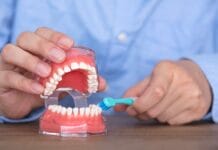Note: This is Part 2 of Debbi Viger’s series, Special Needs: Everyone Has Special Needs. Read Part 1 here.
If every patient is to be treated as special, young children need to be treated as super special! It is most important that young children learn to love the dental office. We can eliminate fear and apprehension by setting the future of dental appointments with a stress-free, stellar start. It is best to start early with educating the parents-to-be on proper daily home care, nutrition for dental health, and a request to start their child’s appointments at age one. If we set the stage for prevention and happy, educational visits, we can predict a life free of dental fear.
At that first appointment, we want to spend the bulk of the time educating. This is when we do a knee-to-knee examination. Have a parent hold the child with baby’s legs wrapped around their waist and head by the parents’ knees; the dental professional is then knee-to-knee with the parent and has full access to the child’s head and neck. Fully examine the soft tissues, potential tongue and lip ties, eruption patterns, and teeth. Show the mirror and explorer to both child and parent. Count fingers first to build comfort and then move on to teeth. All the while discussing what you are seeing and what you expect to see. Alert the parent to any potential issues noted, and possible treatment needs.
Grab that super soft infant brush and do a toothbrush demonstration so that parents see how to create a plaque-free mouth and have them practice in the child’s mouth. How can we expect parents to brush their children’s teeth if we have not provided the education? Let them practice in the office and offer advice. For brushing simplicity and ease of repetition, I teach BOIT brushing to all; bumpy, outside, inside, tongue. Wet the soft brush, apply a rice-sized portion of paste/gel or leave off if sensory issues are found. Try all sorts of flavors for added interest.
Always teach starting in the upper right, do all maxillary teeth, drop to the mandibular left and complete the arch. This is the first of three complete circles. “Bumpy” is the biting surface; tell parents this allows the paste time to sink into the teeth. “Outside” are the parts of the teeth you see when they smile; again upper right maxillary to start, then follow all the way around completing the second circle. Next, the “insides” which are the teeth surfaces by the tongue; again upper right and all the way around. Three complete circles and then the tongue gets a quick brushing. At this young age, a cloth can be used to remove excess saliva or paste. Maybe a disclosing toothpaste is needed to help accuracy. Also advise what types of paste and brushes, or cloths, will work best for their child. The more information given, the better the outcome.
Take this opportunity to mention hidden sugars and sleeping with a bottle or sippy style cup. Many parents still do not realize that free access to juice, milk, and formula, leads to decay. Stress water as the only beverage for non-mealtimes. Discuss how yogurt can be nutritiously beneficial but to check the sugar concentration. One-digit sugars will be a better option than higher levels of sugar and explain how four grams of sugar equals a teaspoon. Keep a yogurt cup handy of child flavored yogurt and circle the sugars on the package, then compare to a portion of greek yogurt, and see the significant difference. Show labels of 100% juice and remind parents it’s not all about organic and non-GMO, it is about introducing too much sugar in the diet. Do the same with a box of raisins and discuss the sticky nature of foods that adhere to the pits and fissures of teeth which can pose a decay risk. Use this short appointment to set the stage for a lifetime of excellent oral health.
If the appointment is progressing nicely, take this time to demonstrate the prophy angle. Let the child listen to the sounds and feel the rubber cup on a parent’s finger and then on their own. If behaviors are still excellent, use a tiny bit of fine prophy paste and begin on the anterior teeth and gently polish.
The most important aspect of the initial appointment is educating the parent; stop if the child begins to fuss. Brushing alone is a huge win. Apply a fluoride varnish in a mild flavor at the conclusion of the appointment. Offer a written sheet outlining brushing technique, nutrition examples, and a reminder to return in 6 months, or as needed if there is an issue. Remind parents that daily brushing is necessary and that it gets easier with practice and the reward is a decay free mouth.
Making a child’s first dental appointment, the “happy visit,” stress-free and a happy experience, can set a child up for a lifetime of dental health without apprehension of the dental office. It is also an imperative time to educate parents on oral health, oral care at home, and healthy nutrition choices. As dental hygienists, the impact you can make on even your tiniest patients is so powerful. I encourage you to be that impactful hygienist!
NOW READ: Pediatric Dental Hygiene: How Can You Work on Kids?!












